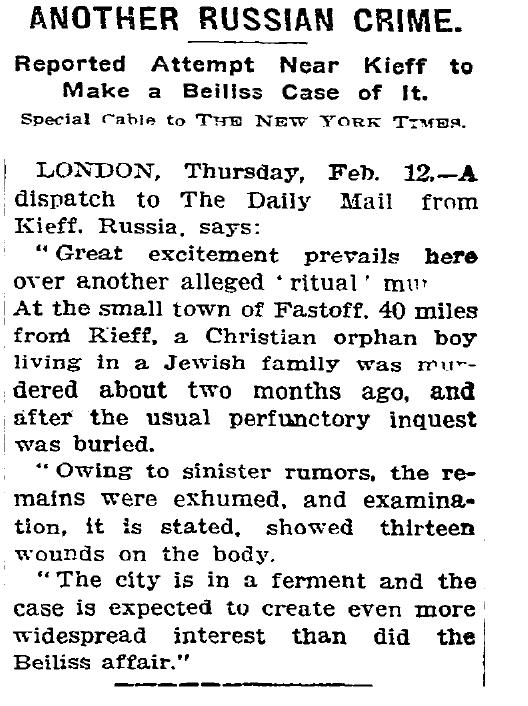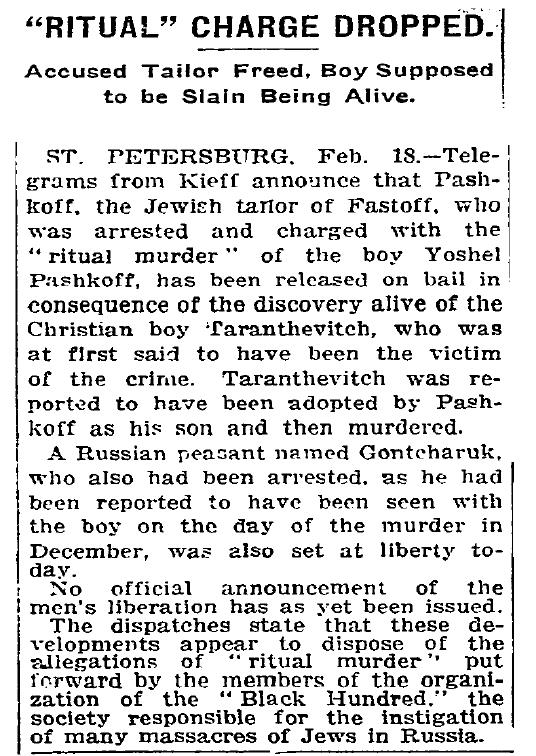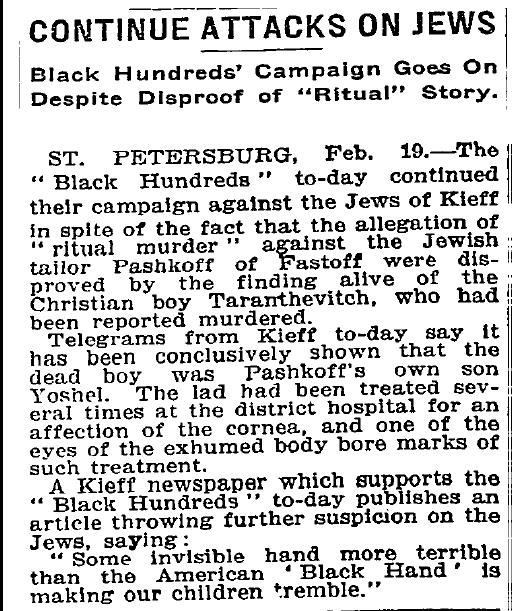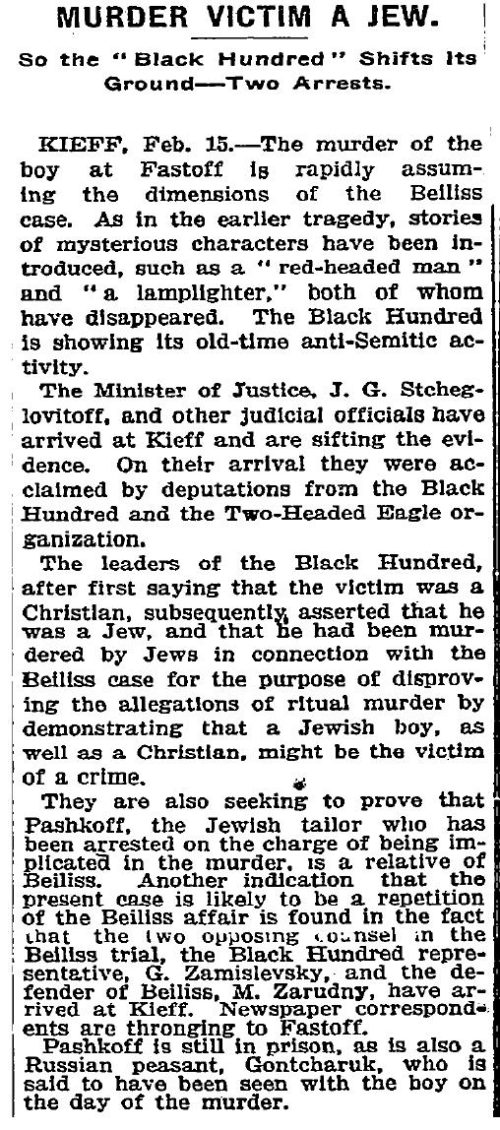From “Paper Life.”
The Ronen family was touched by a perverse blood libel accusation that followed on the heels of the acquittal of Mendel Beilis in October, 1913. Nechamka wrote this story to Fannie:
Now I’ll write you some words about our uncle. This is true. His son Yossel was brutally killed the same way as Yushchensky.[1] He had 13 wounds. In addition to that horror, there were some people who said they recognized the Russian boy who disappeared some weeks ago. As a Jew has no rights in Russia, an innocent man was put into jail and without a single proof was put into prison and was accused of murder. Only because a woman on the street said she thought he killed the Russian boy. Together with our uncle his manager Ostrovsky was arrested [all the contemporary publicity identifies the manager, or clerks as Guthartz]. The whole small town [village] was furiously boiling. They said that our uncle killed a Christian boy and sent his own son to America. It’s unbelievable, incredible, scary, but that’s what happened. They opened the case, but luckily the difference between Jewish and Christian boys was evident and many other proofs showed that a Jewish boy had been killed and it was Joseph (Yossel). We bailed them out; for seven days they had been kept like the worst criminals in prison. The case is still not closed. There will be a trial for Goncharuk, who killed the child. We have to thank God that this didn’t turn into the famous case of Beylits [sic]. Can you imagine the situation, when your son is brutally killed and the father is accused of the murder?[2]
I have corroborated this story, which is reported in numerous newspaper articles of the day as well as in “The Decay of Czarism: The Beiliss Trial” by Alexander B. Trager. This book’s material is based on unpublished Russian archival materials; the translated book was published by the Jewish Publication Society of America in 1935. Here is the pertinent information, beginning on page 221. The background is that a month after Beiliss’ acquittal, the right-wing prosecutors who had lost the Beiliss case wanted to implicate him further and to support the charge that the Jews were committing “ritual murder.”
Instead of renewing the attempts to prove that Beiliss was a ritual murderer, the Kiev monarchists, again in alliance with some of the Procurators, decided that it was better to organize a new ritual trial and in this way to rehabilitate also the accusation against Beiliss…
On November 27, 1913, the corpse of a boy of eleven or twelve was found in the hamlet Fastov, situated not far from Kiev. There were thirteen knife wounds on his neck – the exact number required for a ritual murder, in accordance with the assertions of the charlatans of various countries…
During the very first stages of the investigation, the corpse was recognized and identified; the victim was Yosel (Joseph) Pashkoff, a Jew, son of a tailor, Froim (Ephraim) Pashkoff, a resident of Fastov…
Acting Chief Procurator was Volodkovich, one of the Assistant Procurators [during the Beiliss trial]. The latter decided to outdo even Chaplinsky [former Chief Procurator who had prosecuted Beiliss], and invented a criminal plan compared with which the Beiliss affair was child’s play. He started his activities by an order to make it clear whether the murdered boy was really one of the sons of Pashkoff or whether it might not be that the Jew murdered a Christian boy and affirmed that the victim was his son in order to conceal the crime…
The Right monarchist press, endorsing the invention of Volodkovich, began to spread rumors that the Jewish boy Pashkoff had fled ‘together with Beiliss’ to America [Beiliss actually went to Palestine after his acquittal, moving to the US years later], and that a murdered Christian boy had been buried in Fastov under Pashkoff’s name. ‘The acquittal of Beiliss,’ asserted the reactionary elements everywhere, ‘encourages the commission of ritual murders.’ The Novoye Vremia zealously took upon itself the popularization of this official version: ‘The simulation of the Jewish origin of the boy and of the family name of Pashkoff is suspected . . . There are thirteen wounds on the face of the assassinated.’
Froim Pashkoff, the unfortunate father who had lost his son, was imprisoned as the person accused of ritual murder. The authorities had no knowledge, however, of any Christian child who might have been killed or had disappeared from the neighborhood at that time…No less than three Christian boys were identified in this way, who were said (but not proved) to have disappeared. It only remained to choose one of these three candidates for the role of the corpus delicti…
The vacant post of the Kiev Chief Procurator had just been filled. The new appointee, Nicholas Chebysheff, had the reputation of an honest person, and he did not care to follow in the footsteps of his predecessors. Suddenly, all the boys who were alleged to have disappeared and had been identified with the decomposed corpse of Yosel Pashkoff, were found alive. The father of Pashkoff was released from prison, and soon after it was discovered, without any particular difficulty, that the unfortunate son of the tailor Pashkoff had been killed by the professional criminal Ivan Goncharuk, who had a record of ten convictions to his credit, had been arrested for possessing a forged passport, and was sought also for another serious crime. The case was investigated in a normal way, Goncharuk was tried, found guilty, and was sentenced to imprisonment at hard labor in Siberia…
The situation in the Fastov case was different; here the attempt was made to stage not merely a ritual trial but the ritual murder itself. It failed because of a mistake of the murderer, who did not know that he was inflicting the thirteen knife wounds on the body of a Jewish boy.[3]
The stated facts match Nechamka’s precisely:
- The murdered child is named Yossel,
- The murder took place in Fastov,
- There were 13 stab wounds,
- It was alleged that Russian boys had disappeared,
- The rumor was that the father had sent his son to America,
- The child was found to be Jewish,
- The murderer’s name is Goncharuk/Gorcharuk (I believe that the translator of Nechamka’s letter misread the “n” for an “r,” an easy mistake to make with Russian handwriting).
I do not doubt that Nechamka’s story is 100% corroborated, that we now know Yossel’s last name and his father’s name, Froim (Ephraim) Pashkoff, and that Froim was a tailor. Nechamka refers to the uncle owning a “factory” whereas the Trager book and newspaper articles says he was a tailor. This is not necessarily inconsistent: many “factories” were small garment operations. Clearly this is the identity of at least one uncle in Fastov to whom the family letters refer. There may have been more than one uncle, and we don’t know if this is Chana’s brother or an uncle by marriage.
I believe it was this family that fled to the Ronen’s after the Fastov pogrom in 1919, when an uncle was killed.[4] I have corroborated Froim Pashkoff’s death in the 1919 Fastov pogrom through the Israel Genealogical Research Association’s All Israel Database.[5]
The American Jewish Year Book, Volume 17 (Sept 1915-Sept 1916), notes that on January 15 in Kiev, “Judicial authorities abandon ritual charge against Jews Pashkoff and Guthartz, of Fastov” and that on “March 26: Court permits M. Pashkoff to claim damages for murder of his child, at Fastov, by Gontcharuk.”[6] Keep in mind that date discrepancies may be due to the use of the Julian calendar in the Russian Empire. One discrepancy is that Nechamka gives Ostrovsky as the name of the factory manager who was also arrested; I don’t know how “Guthartz” is connected to the case.
News coverage of the case was widespread in London and the US: I have seen reports from California, Oregon, Utah, Minnesota, Texas, Philadelphia, Louisiana, Idaho and elsewhere. One tantalizing element is the hint that perhaps Pashkoff was related to Menachem Mendel Beilis. One wonders why Pashkoff in particular was accused of the murder and whether the murderer was aware that the child he killed was Pashkoff’s son, or was the child randomly selected, all of which would have interesting implications. One also wonders what to make of the assertion that the Pashkoff family had “adopted” a Christian orphan. Here is the New York Times’ coverage from 1914:
Footnotes
[1] Andrei Yushchensky was the child who Beilis was accused of having murdered.
[2] Nechama Ronen to Fannie, Kiev, March 1914
[3] “The Decay of Czarism: The Beiliss Trial” by Alexander S. Trager, pp. 221-224
[4] Franka Ronen to Fannie, Kiev August 30, 1922
[5] From the Megilat Hatevah A-S, Prof. Gur Alroey, part of the Scroll of the Slaughter database, IGRA number 9531. The original records are from Genazim Archive.
[6] The American Jewish Year Book, Volume 17, ed. Cyrus Adler, Henrietta Szold, p. 242





